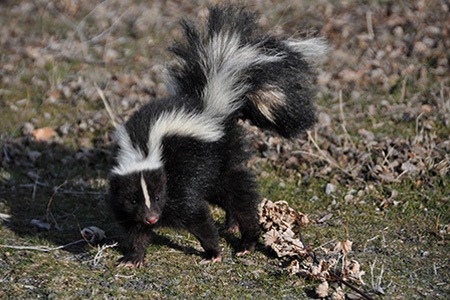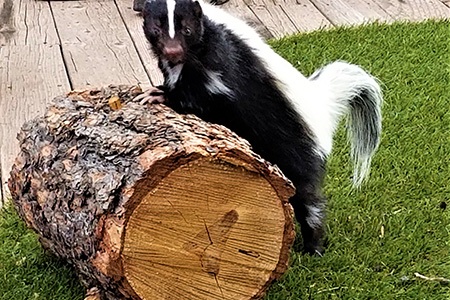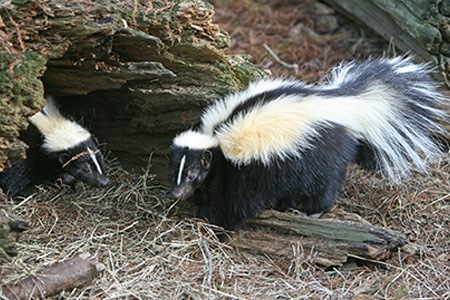Can Skunks Climb Fences, Trees, or Homes?
Author: Jen Worst | Editor: Omar Alonso
Review & Research: Jen Worst & Chris Miller

Can skunks climb? This intriguing question has likely crossed the minds of many homeowners who are concerned about potential damage to their property. In this comprehensive blog post, we will delve into the anatomy and climbing abilities of these fascinating creatures.
We will explore various aspects of skunk anatomy and the limitations of their claws and legs in relation to climbing trees or other surfaces like cinder block walls.
In addition to understanding how well skunks can climb different structures, it's important for homeowners to know how they can deter them from entering their properties. We'll cover effective fencing techniques and barriers that prevent skunks from accessing your home or garden. Additionally, we'll examine repellents and traps which can be bought, as well as natural predators that could help keep skunks away.
Lastly, we'll provide valuable safety precautions when dealing with skunks so you're prepared if you ever encounter one on your property. Can skunks climb? Read on to find out more!
Skunk Anatomy

Understanding the anatomy of skunks is essential for homeowners looking to make repairs on their homes and prevent these creatures from causing damage or creating unpleasant odors. In this section, we will explore the physical characteristics, diet and habits, and reproduction of skunks.
Physical Characteristics
Skunks, from the Mephitidae family, are identifiable by their striking black-and-white coats and a powerful odor they use to deter predators. They have short legs with sharp claws that aid in digging burrows or searching for food underground. The size of skunks varies greatly, with a body length ranging from 40-80 cm (16-31 inches) and weight between 0.5 kg to 8 kg (1 lb -17 lbs).
Diet & Habits
Skunks are omnivorous animals with a diverse diet consisting of insects, grubs, rodents, berries, fruits, and even garbage left by humans. They are primarily nocturnal creatures but can be active during daylight hours if they feel safe enough or need extra time searching for food resources, including:
- Insects: Beetles, grasshoppers, caterpillars, worms, wasp larvae, etc.
- Rodents: Mice, rats, squirrels, etc.
- Fruits & Vegetables: Potatoes, pumpkins, cucumbers, elderberries, etc.
- Garden Waste: Trimmings, leftovers, grass clippings, etc.
Skunk Climbing Ability

Understanding a skunk's climbing ability is essential for homeowners looking to protect their property from these creatures. In this section, we will discuss the limitations of skunks' claws and legs, their adaptations for climbing trees, and other surfaces they can climb.
Limitations of Claws & Legs
Can skunks climb even with their tiny legs? Skunks have relatively short legs compared to other mammals like raccoons or squirrels. Their claws are long and curved, which are primarily designed for digging rather than climbing. While these physical characteristics may limit their overall agility on vertical surfaces, it does not mean that they cannot climb at all.
Adaptations for Climbing Trees
Do skunks climb trees? Skunks have been observed scaling trees for sustenance or to evade predators, such as birds of prey and bigger mammals like coyotes. They do so by using their strong front limbs to grip onto branches while pushing themselves up with their hind legs.
To further aid them in tree-climbing endeavors, skunks possess sharp teeth that can be used to bite into bark if necessary—providing additional support during ascent. Can skunks climb trees? Do skunks climb trees? They can and do, though we don't observe it much near our homes.
Other Surfaces Skunks Can Climb
- Fences: Although not adept climbers like raccoons or squirrels, skunks can still manage to scale fences made out of wood or chain-link material if there is enough traction available.
- Rocks: Similarly, rocky terrain might provide sufficient footholds for a determined skunk seeking higher ground—especially when escaping from potential threats on the ground level.
- Stacked Objects: Homeowners should be cautious about leaving piles of firewood, bricks, or other stackable items near their homes. Skunks may use these as makeshift ladders to gain access to rooftops or elevated decks.
All of this means that skunks can scale up the side of your home. Can skunks climb into attics? They can if you have an opening large enough for them to enter. This would be extremely rare to ever encounter this scenario, though, even if your house smells like skunk. They're more likely to be under the porch or in your crawl space.
Deterring Skunks From Your Property

Can skunks climb walls? Can skunks climb fences? Skunks can be a nuisance to homeowners, especially when they climb fences or walls and enter your property. To prevent skunks from causing damage or spraying their foul-smelling musk, it's essential to take proactive measures in deterring them.
Fencing & Barriers
One effective way to stop skunks is by installing proper fencing around your property. Since skunks can climb cinder block walls, brick walls, and even chain link fences, you should consider using wire fences with small openings that are difficult for them to grip onto. Bury the fence at least 1-2 feet underground as this will also help deter other burrowing animals like groundhogs.
Repellents & Traps
Can skunks climb? Yes, but you don't need to worry about it if they aren't around. In addition to physical barriers, there are several repellent options available that can discourage skunk activity on your property:
- Predator urine: Applying predator urine (such as fox or coyote) around the perimeter of your yard can make skunks feel threatened and less likely to enter.
- Natural repellents: Sprinkle substances like ammonia-soaked rags or mothballs near potential entry points; however, these may need frequent reapplication due to weather conditions.
- Live traps: If you have an existing problem with a persistent skunk visitor(s), consider using live traps designed specifically for capturing these critters humanely so they can be relocated safely away from residential areas.
Natural Predators
Encouraging natural predators to visit your property can also help control skunk populations. For example, owls are known to prey on small mammals like spotted skunks, and installing an owl nesting box in your yard may attract these helpful hunters. However, be cautious when encouraging predator activity as they may pose a threat to other wildlife or pets in the area.
Safety Precautions When Dealing With Skunks

When it comes to dealing with skunks around your property, safety should always be a top priority. Can skunks climb? Yes, and they can climb you, doing significant damage in the process.
These creatures may carry diseases and can spray a pungent odor when threatened. In this part, we'll talk about the steps you can take to avert any disagreeable meetings or health dangers.
Avoiding Contact With Skunks
The first step in ensuring your safety is avoiding direct contact with skunks whenever possible. If you spot one on your property, give it plenty of space and do not attempt to approach or corner it as this may provoke an aggressive response.
- Maintain distance: Keep at least 10 feet away from the animal to minimize the risk of being sprayed.
- Avoid sudden movements: Move slowly and calmly if you need to pass by a skunk, as they are more likely to spray when startled.
- No feeding: Do not feed wild animals like skunks, as this encourages them to associate humans with food sources and increases the likelihood of future encounters.
Wearing Protective Gear
If you must handle materials that have come into contact with skunk odor or feces (such as removing contaminated items from your yard), wearing protective gear is essential for minimizing exposure risks. The Centers for Disease Control and Prevention (CDC) recommends taking these measures:
- Gloves: Wear disposable gloves while handling potentially contaminated materials.
- Coveralls: Use disposable coveralls or washable clothing that can be easily cleaned after use.
- Masks: Wear a mask to protect your respiratory system from inhaling harmful particles and odors.
Seeking Professional Help if Necessary
For those in need of assistance with skunk removal, a professional wildlife service can provide the necessary expertise and equipment to do so safely. These experts have the necessary knowledge, experience, and equipment to safely remove skunks without causing harm or distress.
Some situations where professional help may be warranted include:
- A persistent skunk problem despite attempts at deterrence
- A trapped or injured skunk in need of assistance
- Evidence of disease (such as erratic behavior) in the animal
To find a reputable wildlife removal company near you, check out resources like the National Wildlife Control Operators Association (NWCOA).
Can Skunks Climb? Yes, But…
Skunks may not be built for scaling, but they do possess traits that let them ascend trees, walls and fences. However, there are steps you can take to deter skunks from your property using fencing, repellents or traps.
If you encounter a skunk on your property, it's best to take necessary safety measures such as keeping your distance and seeking professional assistance if needed. With these tips in mind, you can protect your home from unwanted visitors. Can skunks climb? Yes, but you can manage any issues with the information here.



